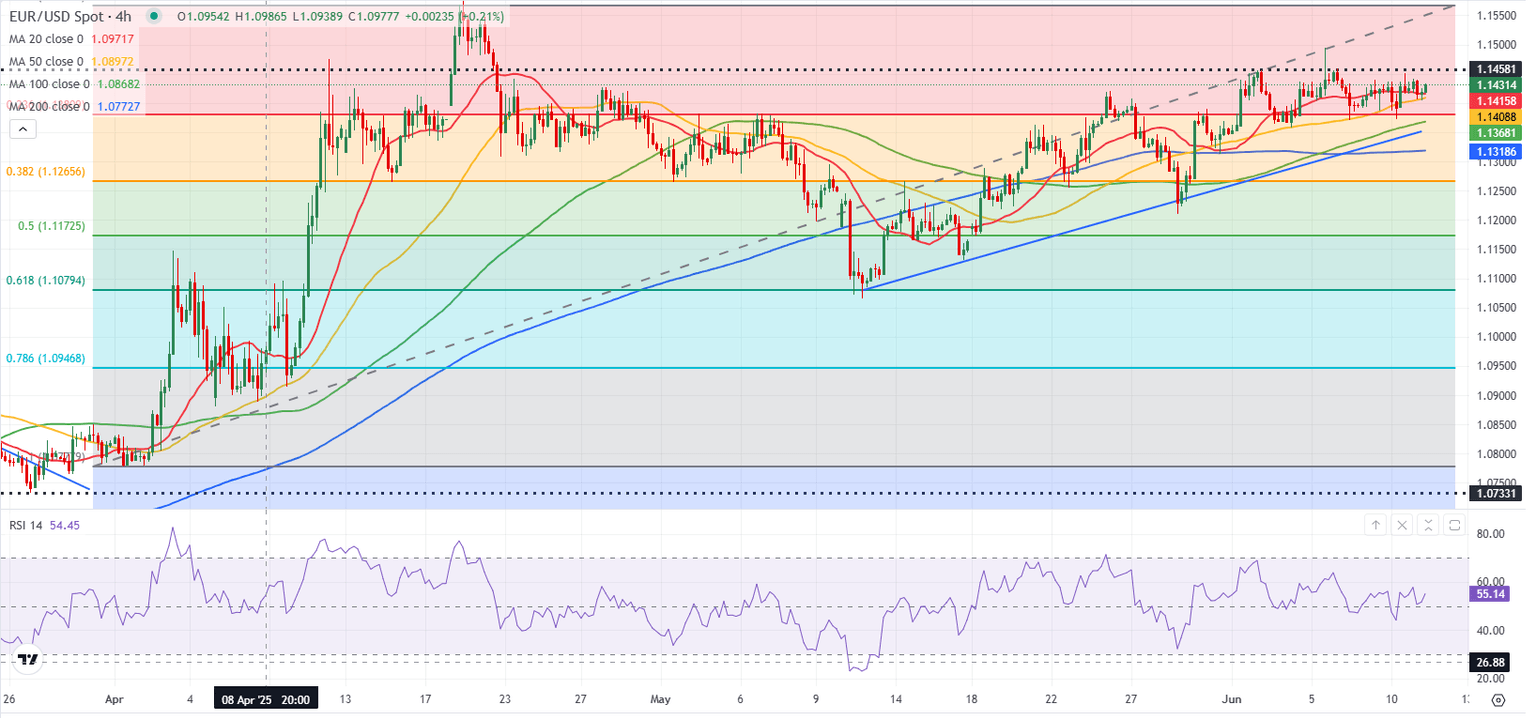EUR/USD Forecast: Euro remains within tight range ahead of US inflation data
- EUR/USD continues to move sideways slightly above 1.1400 on Wednesday.
- The technical outlook highlights the pair's indecisiveness in the near term.
- The US economic calendar will feature inflation data for May.

EUR/USD struggles to make a decisive move in either direction and continues to move up and down in a narrow channel at around 1.1400 in the European morning on Wednesday. May inflation data from the US could trigger the next big market reaction and help the pair break out of its range.
Euro PRICE This week
The table below shows the percentage change of Euro (EUR) against listed major currencies this week. Euro was the weakest against the New Zealand Dollar.
| USD | EUR | GBP | JPY | CAD | AUD | NZD | CHF | |
|---|---|---|---|---|---|---|---|---|
| USD | -0.28% | 0.30% | 0.13% | -0.10% | -0.21% | -0.21% | 0.03% | |
| EUR | 0.28% | 0.57% | 0.41% | 0.16% | 0.08% | 0.06% | 0.30% | |
| GBP | -0.30% | -0.57% | -0.06% | -0.41% | -0.48% | -0.51% | -0.27% | |
| JPY | -0.13% | -0.41% | 0.06% | -0.25% | -0.41% | -0.42% | -0.24% | |
| CAD | 0.10% | -0.16% | 0.41% | 0.25% | -0.12% | -0.10% | 0.13% | |
| AUD | 0.21% | -0.08% | 0.48% | 0.41% | 0.12% | -0.02% | 0.20% | |
| NZD | 0.21% | -0.06% | 0.51% | 0.42% | 0.10% | 0.02% | 0.24% | |
| CHF | -0.03% | -0.30% | 0.27% | 0.24% | -0.13% | -0.20% | -0.24% |
The heat map shows percentage changes of major currencies against each other. The base currency is picked from the left column, while the quote currency is picked from the top row. For example, if you pick the Euro from the left column and move along the horizontal line to the US Dollar, the percentage change displayed in the box will represent EUR (base)/USD (quote).
The modest improvement seen in market mood helped the US Dollar (USD) hold its ground and made it difficult for the pair to gain traction on Tuesday. After negotiating for two days in London, officials from China and the United States (US) agreed to ease export curbs, including the ones on rare earths, and to keep the tariff truce alive.
Later in the session, the US Bureau of Labor Statistics will publish the Consumer Price Index (CPI) figures for May.
On a yearly basis, the CPI is forecast to rise 2.5%, compared to the 2.3% increase reported in April.
The core CPI, which excludes volatile food and energy prices, is expected to rise 0.3% on a monthly basis. In case this data comes in above the market forecast, the USD is likely to gather strength with the immediate reaction and weigh on EUR/USD. On the flip side, a reading of 0.2%, or lower, in this figure could feed into expectations for two Federal Reserve (Fed) rate cuts this year and hurt the USD.
According to the CME FedWatch Tool, markets are currently pricing in about a 60% of the Fed cutting the policy rate at least twice in 2025.
EUR/USD Technical Analysis

The Relative Strength Index (RSI) indicator on the 4-hour chart stays slightly above 50 and EUR/USD continues to fluctuate at around the 20-period and the 50-period Simple Moving Averages (SMA), highlighting a lack of directional momentum.
On the downside, the first support level could be seen at 1.1380-1.1370 (Fibonacci 23.6% retracement of the latest uptrend, 100-period SMA) before 1.1320 (200-period SMA). Looking north, resistances could be seen at 1.1450 (static level), 1.1500 (static level, round level) and 1.1575 (April 21 high).
Euro FAQs
The Euro is the currency for the 19 European Union countries that belong to the Eurozone. It is the second most heavily traded currency in the world behind the US Dollar. In 2022, it accounted for 31% of all foreign exchange transactions, with an average daily turnover of over $2.2 trillion a day. EUR/USD is the most heavily traded currency pair in the world, accounting for an estimated 30% off all transactions, followed by EUR/JPY (4%), EUR/GBP (3%) and EUR/AUD (2%).
The European Central Bank (ECB) in Frankfurt, Germany, is the reserve bank for the Eurozone. The ECB sets interest rates and manages monetary policy. The ECB’s primary mandate is to maintain price stability, which means either controlling inflation or stimulating growth. Its primary tool is the raising or lowering of interest rates. Relatively high interest rates – or the expectation of higher rates – will usually benefit the Euro and vice versa. The ECB Governing Council makes monetary policy decisions at meetings held eight times a year. Decisions are made by heads of the Eurozone national banks and six permanent members, including the President of the ECB, Christine Lagarde.
Eurozone inflation data, measured by the Harmonized Index of Consumer Prices (HICP), is an important econometric for the Euro. If inflation rises more than expected, especially if above the ECB’s 2% target, it obliges the ECB to raise interest rates to bring it back under control. Relatively high interest rates compared to its counterparts will usually benefit the Euro, as it makes the region more attractive as a place for global investors to park their money.
Data releases gauge the health of the economy and can impact on the Euro. Indicators such as GDP, Manufacturing and Services PMIs, employment, and consumer sentiment surveys can all influence the direction of the single currency. A strong economy is good for the Euro. Not only does it attract more foreign investment but it may encourage the ECB to put up interest rates, which will directly strengthen the Euro. Otherwise, if economic data is weak, the Euro is likely to fall. Economic data for the four largest economies in the euro area (Germany, France, Italy and Spain) are especially significant, as they account for 75% of the Eurozone’s economy.
Another significant data release for the Euro is the Trade Balance. This indicator measures the difference between what a country earns from its exports and what it spends on imports over a given period. If a country produces highly sought after exports then its currency will gain in value purely from the extra demand created from foreign buyers seeking to purchase these goods. Therefore, a positive net Trade Balance strengthens a currency and vice versa for a negative balance.
Premium
You have reached your limit of 3 free articles for this month.
Start your subscription and get access to all our original articles.
Author

Eren Sengezer
FXStreet
As an economist at heart, Eren Sengezer specializes in the assessment of the short-term and long-term impacts of macroeconomic data, central bank policies and political developments on financial assets.

















